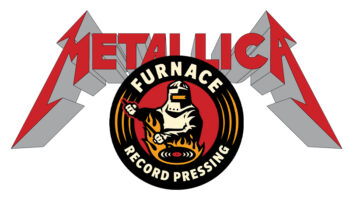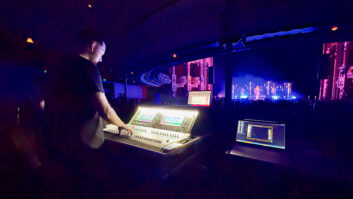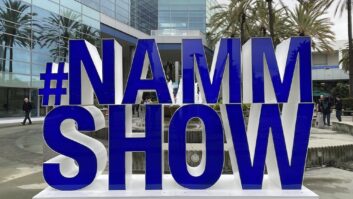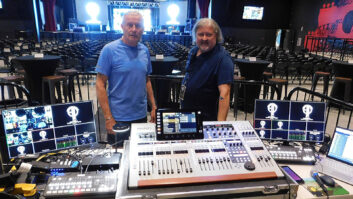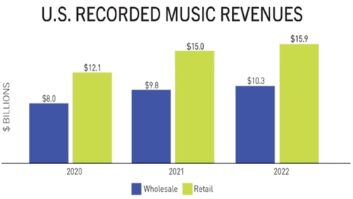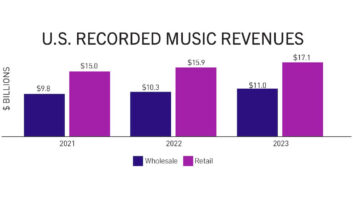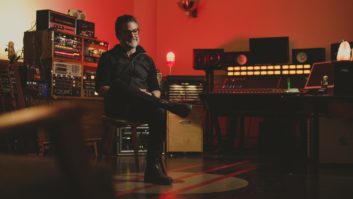Since 2007, vinyl records have been making a remarkable comeback at retail, with sales growing exponentially year over year. The latest Nielsen Soundscan figures found vinyl LP sales climbed another 17.7 percent in 2012 to reach 4.6 million albums sold. That success hasn’t gone unnoticed—hipsters are buying records; major chains like Hot Topic, Urban Outfitters, Best Buy and FYE have started carrying LPs; and now in a surprising turn of events, bootleg vinyl is making a comeback, too.

The first bootleg:
Bob Dylan’s Great White Wonder. Photo: Azio Media
From July, 1969, when the first bootleg came out—Great White Wonder, a 2-LP set of Bob Dylan tracks—up through the turn of the millennium, there were two music industries: the legitimate one, whose products you saw at the mall and which you could read about in Billboard; and the underground one, whose products could be found in independent record shops, flea markets and the classifieds of Goldmine magazine, listed under the euphemism “imports.” For decades, the RIAA tried to stamp out that river of illicit releases with varying degrees of success, but despite the organization’s best efforts, bootleggers continued to pump out albums of rock stars’ concerts and unreleased tracks, and like the legitimate record companies, left vinyl behind when they made the leap to silver CDs with the advent of digital replication.
The bootleggers did eventually bite the dust, however, but not because they wound up in jail (though some did). Rather, the dual plagues of digital piracy and internet downloading were indiscriminate in who they affected—major labels, indie labels and illicit labels were all hit hard, but if the majors had a hard time “competing against free,” criminals working out of the trunks of their cars were even less well-equipped to go up against the likes of Napster.
Ironically, today’s consumer technologies make the return of bootlegging-for-profit even more unlikely. Go to any concert and you’ll see dozens of people openly shooting video on their smartphones and instantly posting the results to YouTube while they stand there in the audience. Just 10 years ago, shooting video (presuming you snuck a camera in somehow) would get your videotape confiscated and your backside thrown out the door—or maybe in jail. Now it’s just the way things are: A soccer mom can capture that Bon Jovi concert for posterity and distribute it to a worldwide audience in seconds—and no one bats an eye.
So why would bootlegs come back now, and on a comparatively creaky, analog medium like vinyl records? Back in the day, bootlegs were most often found in mom ‘n’ pop record stores, and since 67 percent of all vinyl purchases in 2012 were made in independent music stores, the two trends appear to have merged. It makes sense, considering that indie shops cater to die-hard collectors, but even so, as consumers, they have better options for obtaining illicit music, rather than spending money on what traditionally is a disappointing purchase. After all, the material on the bootlegs themselves is merely a Google search away. Much like their heyday in the 1970s and ’80s, most bootlegs continue to focus on major Baby Boomer rock acts like Bruce Springsteen, The Beatles and the Rolling Stones, all of whom are exhaustively documented and downloaded in dark corners of the internet.

A recent Radiohead concert bootleg on vinyl. Photo: Katiohead.
Considering all those drawbacks, why would people buy modern-day bootlegs? I asked blogger Katiohead, who has picked up more than a few Radiohead boots on vinyl, and she responded, “I am sure that everything I have is available digitally…[so] what makes me buy the vinyl? Commodity fetishism. I collect Radiohead, so I want to buy up ALLLLLLLL the vinyl I can find. I have acquired all of my vinyl through Amazon, Ebay, Discogs, and at the two record stores in Portland that I go to frequently. Both the BBC Sessions and the Jaydiohead vinyl [bootlegs] were in record stores here.”
Over at the internet forum Record Collectors Guild, one collector posted extensively about his collection of Pink Floyd bootlegs, and while some were vintage editions from the 1970s, at least a few came from recent times, such as Last Gigs In The Sky, a 2011 collection that included the band’s final performance at Live 8 in 2005. When I contacted him about the collection, he shared (after asking not to be named), “I got the album not long ago at a record convention in Austin, TX. It was in a box of other vinyls that weren’t worth more than a few dollars a piece. I paid $35 for the whole box, very easily worth it for this really neat, clear white vinyl. The sound is superb quality, very clear!”

Some releases by the Alti Philosophi and Arkain Filloux labels.
Photo: Little Black Star.
The Seattle-based blog Little Black Star, too, posted at length (though the posts have since been removed) about the bootleg labels Alti Philosophi and Arkain Filloux, which specialize in cult bands like The Mars Volta and The Cramps. The site opined, “One thing to keep in mind. These are bootlegs of a fairly mediocre quality. Most are sourced from MP3s. This seems to be little more than a money grab with the twist of screenprinted covers. They seem hastily put together and are hit and miss when it comes to quality.” It’s fair to note that despite the disparaging review, the blogger bought a lot of the labels’ indie-oriented releases.
In order to fully report on the topic, we picked up two modern-day vinyl bootlegs (strictly for journalistic purposes, of course), starting with Marching In Time, an Alti Philosophi album of demos by film composer Danny Elfman’s new wave band, Oingo Boingo. While it looked relatively impressive, released on orange vinyl and housed in a hand-silkscreened sleeve, the record itself was clearly sourced from ratty, low-quality MP3 files, resulting in a washy, brittle sound that made it hard to listen to for any length of time.
At the other end of the spectrum, however, was The Smiths: Unreleased Demos & Instrumentals, a two-album set that made such a splash when it was released that even rollingstone.com covered it. Issued on blue vinyl, the tracks had never previously leaked out in any format. Even more surprising, the sound quality approached that of a major label release, and online conjecture suggests that the songs were originally compiled to be bonus tracks on various cancelled reissue projects over the years. Even the packaging was carefully thoughtout, keeping in step with the band’s penchant of using 1960s British movie stars on its covers—in this case, actress/singer Diana Dors.

Will this unexpected resurgence in bootleg vinyl grow exponentially like legal releases have? Probably not. Despite the uptick, sales numbers remain low for legitimate vinyl (Soundscan named Jack White’s Blunderbuss as the format’s top seller in 2012 at a mere 33,000 copies). With that in mind, as an admittedly unscientific wild guess, proportionally, even projects like that Smiths bootleg must be getting pressed in quantities numbering in the low hundreds, tops. While someone’s making money out there, it probably isn’t enough to garner more than a few token stabs by the record industry to stop them.
Nonetheless, it’s important to remember that bootlegs are illegal for a reason, and purchasing them takes money away from legitimate businesses and musicians, putting cash in the hands of individuals who often use it to fund far more nefarious criminal activities. While it could be argued that buying boots helps independent record stores stay afloat in the age of iTunes and Amazon, only a few indie stores have resorted to stocking them, and with any luck, the continued vinyl revival will hopefully make carrying illegal albums unnecessary for their survival.
